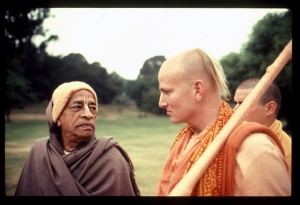CC Madhya 13.155 (1975): Difference between revisions
(Vanibot #0027: CCMirror - Mirror CC's 1996 edition to form a basis for 1975) |
(Vanibot #0020: VersionCompareLinker - added a link to the Version Compare feature) |
||
| Line 2: | Line 2: | ||
<div style="float:left">'''[[Sri Caitanya-caritamrta (1975)|Śrī Caitanya-caritāmṛta (1975)]] - [[CC Madhya (1975)|Madhya-līlā]] - [[CC Madhya 13 (1975)|Chapter 13: The Ecstatic Dancing of the Lord at Ratha-yātrā]]'''</div> | <div style="float:left">'''[[Sri Caitanya-caritamrta (1975)|Śrī Caitanya-caritāmṛta (1975)]] - [[CC Madhya (1975)|Madhya-līlā]] - [[CC Madhya 13 (1975)|Chapter 13: The Ecstatic Dancing of the Lord at Ratha-yātrā]]'''</div> | ||
<div style="float:right">[[File:Go-previous.png|link=CC Madhya 13.154 (1975)|Madhya-līlā 13.154]] '''[[CC Madhya 13.154 (1975)|Madhya-līlā 13.154]] - [[CC Madhya 13.156 (1975)|Madhya-līlā 13.156]]''' [[File:Go-next.png|link=CC Madhya 13.156 (1975)|Madhya-līlā 13.156]]</div> | <div style="float:right">[[File:Go-previous.png|link=CC Madhya 13.154 (1975)|Madhya-līlā 13.154]] '''[[CC Madhya 13.154 (1975)|Madhya-līlā 13.154]] - [[CC Madhya 13.156 (1975)|Madhya-līlā 13.156]]''' [[File:Go-next.png|link=CC Madhya 13.156 (1975)|Madhya-līlā 13.156]]</div> | ||
{{CompareVersions|CC|Madhya 13.155|CC 1975|CC 1996}} | |||
{{RandomImage}} | {{RandomImage}} | ||
==== TEXT 155 ==== | ==== TEXT 155 ==== | ||
<div class="verse"> | <div class="verse"> | ||
:mora bhāgya mo-viṣaye, | :mora bhāgya mo-viṣaye, tomāra ye prema haye, | ||
:sei | :sei prema-parama prabala | ||
:lukāñā āmā āne, | :lukāñā āmā āne, saṅga karāya tomā-sane, | ||
:prakaṭeha ānibe satvara | :prakaṭeha ānibe satvara | ||
</div> | </div> | ||
| Line 20: | Line 19: | ||
<div class="synonyms"> | <div class="synonyms"> | ||
mora bhāgya—My fortune; mo-viṣaye—in relation with Me; tomāra—Your; ye—whatever; prema—love; haye—there is; sei prema—that love; parama | mora bhāgya—My fortune; mo-viṣaye—in relation with Me; tomāra—Your; ye—whatever; prema—love; haye—there is; sei prema—that love; parama pra-bala—very powerful; lukāñā—secretly; āmā āne—brings Me; saṅga karāya—obliges Me to associate; tomā-sane—with You; prakaṭeha—directly manifested; ānibe—will bring; satvara—very soon. | ||
</div> | </div> | ||
| Line 27: | Line 26: | ||
<div class="translation"> | <div class="translation"> | ||
" 'Our love affair is more powerful because of My good fortune in receiving Nārāyaṇa's grace. This allows Me to come here unseen by others. I hope that very soon I will be visible to everyone. | |||
</div> | </div> | ||
| Line 34: | Line 33: | ||
<div class="purport"> | <div class="purport"> | ||
</div> | </div> | ||
Latest revision as of 07:37, 27 January 2020
Śrī Caitanya-caritāmṛta (1975) - Madhya-līlā - Chapter 13: The Ecstatic Dancing of the Lord at Ratha-yātrā

His Divine Grace
A.C. Bhaktivedanta Swami Prabhupada
A.C. Bhaktivedanta Swami Prabhupada
TEXT 155
- mora bhāgya mo-viṣaye, tomāra ye prema haye,
- sei prema-parama prabala
- lukāñā āmā āne, saṅga karāya tomā-sane,
- prakaṭeha ānibe satvara
SYNONYMS
mora bhāgya—My fortune; mo-viṣaye—in relation with Me; tomāra—Your; ye—whatever; prema—love; haye—there is; sei prema—that love; parama pra-bala—very powerful; lukāñā—secretly; āmā āne—brings Me; saṅga karāya—obliges Me to associate; tomā-sane—with You; prakaṭeha—directly manifested; ānibe—will bring; satvara—very soon.
TRANSLATION
" 'Our love affair is more powerful because of My good fortune in receiving Nārāyaṇa's grace. This allows Me to come here unseen by others. I hope that very soon I will be visible to everyone.
PURPORT